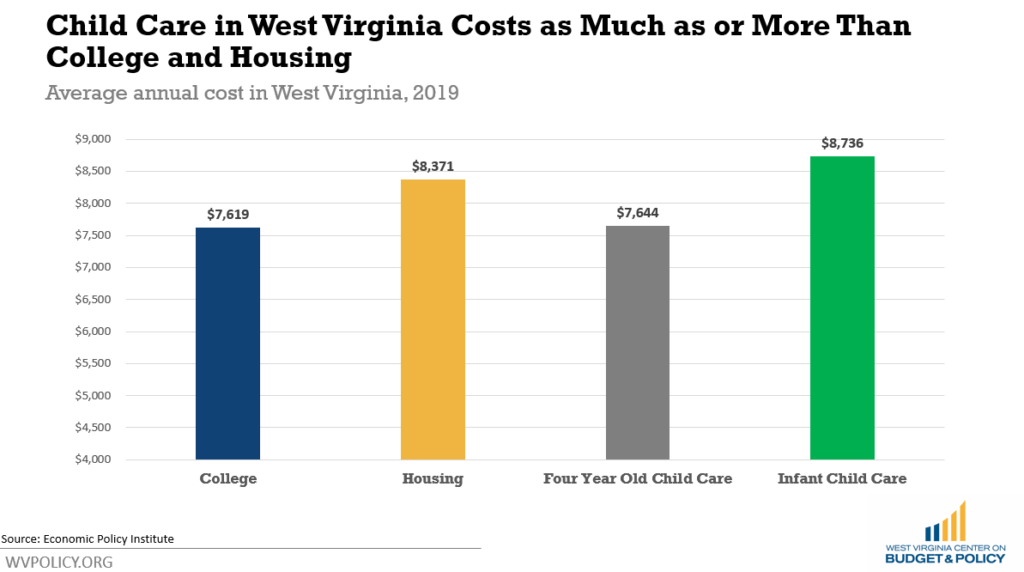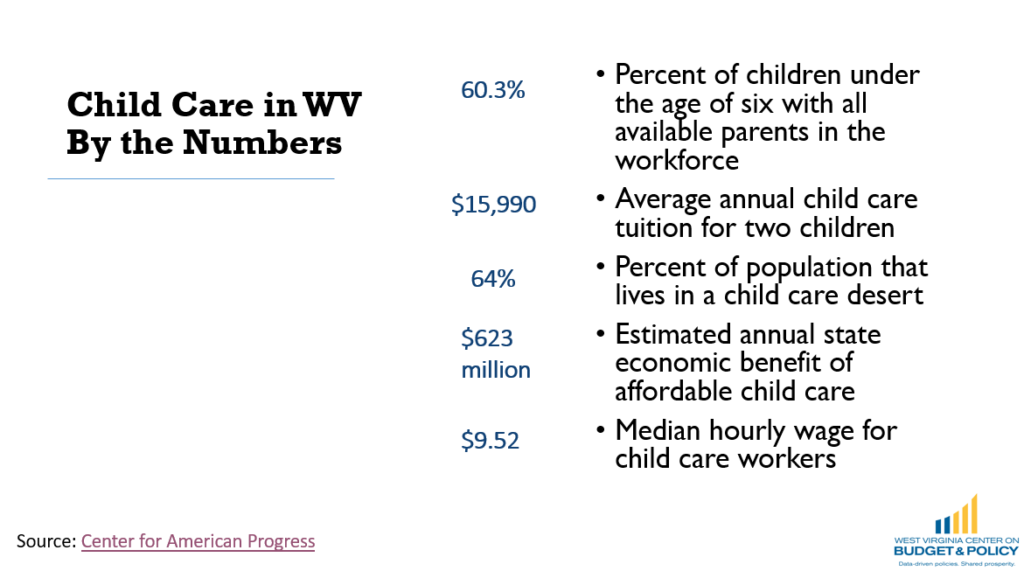The American Jobs Plan, which Congress will consider this year, outlines a bold set of initiatives to invest in America’s infrastructure and renewable energy while ensuring there will be well-paying jobs for generations to come, including for West Virginia workers who have been displaced by the decline of coal. However, these investments will fail to achieve their maximum positive impact if they are not coupled with work and family supports, such as the child care that families need to utilize them. Child care is a critical support for families, supporting working parents while their children are able to learn and be safe in a quality environment. In West Virginia, child care costs as much or more than college tuition and household family housing costs — but unlike preparing for the costs of college, families do not have 18 years to plan for the costs of child care.

This is particularly important in West Virginia, where current child care funding fails to serve all eligible families and nearly two-thirds of families live in a child care desert. Any investment in basic infrastructure must be met with equal investment in our ability to find and afford quality child care. The American Families Plan provides just such investment, with provisions to increase affordability, quality, and the workforce of child care.
The White House’s American Families Plan, a framework for Congressional legislation, outlines three major improvements to our child care system to better support families and ensure a more equitable recovery for all.
First, it seeks to make child care more affordable for families by enacting a sliding scale for household child care costs. Under the framework, low-income families would see their child care costs fully covered, and households at 150 percent of a state’s median household income would have their child care costs capped at no more than seven percent of their household incomes.
Affordability is one the most prevalent barriers to accessing child care. In fact, lack of affordable child care has ripple effects across our economy as it leads some parents to drop out of the labor force entirely in order to care for their children at home.
Current child care assistance programs are primarily funded through the Child Care and Development Block Program (CCDBG). These programs are capped based on federal funding availability with supply falling far below demand. As such, many families who are technically eligible for subsidized child care do not receive any assistance due to a lack of investment in the program.. In West Virginia, only one in six children who were eligible to receive child care assistance according to state eligibility thresholds were served in FY 2016. Nationally, families below the federal poverty line who pay for child care pay 30 percent of their income on average on child care, and families with incomes between 100 and 200 percent of the poverty line pay 18 percent of their income on average on child care. In both cases, this is much higher than the U.S. Department of Health and Human Services’ affordability benchmark, which lays out that child care costs exceeding seven percent of a household’s income are unaffordable. The American Families Plan would seek to correct this.
The American Families Plan also invests in child care providers so they have the resources they need to offer higher quality care. This includes funding for developmentally-appropriate curriculum, smaller class sizes, and culturally- and linguistically-responsive environments that are inclusive of children with disabilities. The plan would also provide job-embedded coaching and professional development opportunities. This prioritizes not just access to child care, but also the social and cognitive development of children while they are being cared for outside the home.
Of course, none of these measures will prove meaningful without a workforce to provide the child care. Currently, nearly half of all child care workers qualify for public income support programs. In West Virginia, the median wage for a child care worker is $9.52 an hour. Low wages and a lack of benefits have led to high turnover, which in turn lowers the quality of care and access overall. The American Families Plan would reverse this by providing a $15 per hour minimum wage for child care workers, and it would ensure that workers with similar qualifications to kindergarten teachers receive the same compensation and benefits as those teachers.
Quality, accessible child care is vital to the American workforce, and the support provided by the American Families Plan rightfully treats this industry like the necessity that it is. While the access to and quality of care would be increased, it also lifts the role of the child care workforce to that of a career. While some assistance has been offered through the American Rescue Plan, and more is included in the American Jobs Plan, Congress must act swiftly to pass the American Families Plan to fully support the economic recovery and future of the American workforce, as well as our nation’s children, families, and child care workers.
